Principle Investigators
Prof. Dr. Wilhelm KleyPD Dr. Roland Speith
PhD Student
Dipl. Phys. Ralf J. GeretshauserIntroduction
There is strong evidence that planets have formed by coagulation of dust in a protoplanetary disc. This process spans size regimes of several magnitudes. It starts with dust grains of 0.1 - 1 μm and terminates with terrestrial planets and cores of gas planets featuring radii of 104 - 106 km. The agglomeration of dust up to centimetre size has been studied by an extensive series of laboratory experiments (Blum and Wurm 2008 and references therein). In this size regime the van-der-Waals force acts as effective sticking mechanism producing highly porous objects within about 1000 years. From radii of 1 km onwards planetesimals possess sufficient gravitational attraction to collect smaller objects. Further growth occurs by accretion. However, in the range of centimetre to kilometre size an efficient growth mechanism still has to be identified and the effect of sticking and fragmentation on the process of planet formation has to be based on a valid collision statistics. Since laboratory experiments are limited in the size of their set up, numerical simulations of dust collisions have to complete the picture. The B4 project of the Forschergruppe is devoted to this task. It will be carried out in a process of three steps:- Calibrating of an existing porosity model by empirically measured material parameters.
- Validating the calibration by reproducing existing laboratory experiments.
- Production of fragmentation statistics by simulation of collisions of dust aggregates with respect to crucial parameters.
Numerical method
The numerical method of Smoothed Particle Hydrodynamics (SPH) was originally developed for the simulation of astrophysical flows (for a detailed review see e.g. Monaghan 2005). It has been expanded to simulate solid material, e.g. brittle material (Benz and Asphaug 2004) and also porous material (Sirono 2004). SPH is meshless which makes it perfectly suitable to simulate problems with open boundaries and problems where fragmentation or plastic rupture can occur. The continuous medium discretised into mass packages (so called "particles") which are carriers of all relevant continuous quantities. They represent the sampling points of the numerical scheme and move according to the Lagrangian form of the equations of continuum mechanics, i.e. Continuity equation and equation of motion, respectively:


The behaviour of solid objects is modelled by replacing the viscous stress tensor by the deviatoric stress tensor.

The later is connected to the deformation of the solid object by a linear constitutive equation via the stress rate:

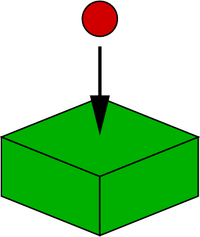
|
| Figure 1: Set-up for experimental calibration. |
Calibrating the porosity model
in collaboration with projects B1, B2, and B3 of the ForschergruppeFor the simulation of porous media we use the model developed by Sirono (2004). It requires input of essential parameters which determine the plastic behaviour of the porous object, and hence the sticking and fragmentation behaviour of two colliding objects. While Sirono bases his simulations on power laws matching the properties of toner particles, our model relies on the material properties of SiO2 dust. The parameters in detail are
- compressive Strength,
- tensile Strength,
- bulk modulus,
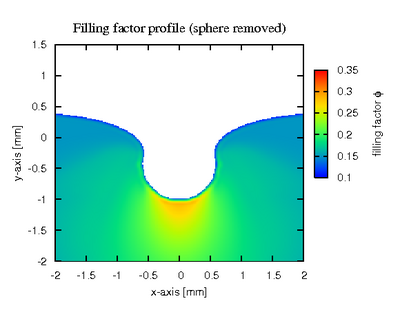
|
| Figure 2: Cut through density structure underneath
the glass bead (removed) after the impact. |
Validating the calibration
in collaboration with projects B1, B2, and B3 of the ForschergruppeFor the validation of compression and shearing properties of the porosity model implemented in ParaSPH experimental and numerical workgroups of the Forschergruppe have developed a benchmark experiment, which was carried out concurrently by simulation and in the laboratory. Under vacuum conditions a glass bead was released to drop into a dust sample (figure 1). During and after the experiment the following features were observed and used for validation:
- deceleration behaviour of the glass bead,
- density structure underneath the glass bead (figure 2),
- intrusion depth of the glass bead,
- relation between impact velocity and intrusion depth of the glass bead,
- total compressed volume of the dust sample.
Parameter studies and fragmentation statistics

|
| Figure 3: Collision of a dust ball with a hard surface (red), preliminary simulation. |
Once ParaSPH is capable of reproducing all essential features found in the experiments the code is validated. Hence it can be utilised to perform simulations in a size regime which is not accessible for laboratory experiments (figure 4). Furthermore crucial collision parameter ranges, such as typical velocity and size distributions, can be simulated systematically and well-grounded fragmentation statistics can be produced. Typical parameter ranges will be derived from simulations of gas and dust dynamics in the protoplanetary disc. The fragmentation statistics will be used in global coagulation models such as described in Brauer et al. (2008).
Literature
-
Benz, W. & Asphaug, E. (2004). Impact simulations with fracture. I -
Method and test. Icarus 107, 98
-
Blum, J. & Schräpler, R. (2004). Structure and Mechanical
Properties of High-Porosity Macroscopic Agglomerates Formed by Random
Ballistic Deposition. Phys. Rev. Lett. 93(11), 115503
-
Blum, J. & Wurm, G. (2008). The Growth Mechanisms of Macroscopic
Bodies in Protoplanetary Disks. Ann. Rev. Astron. & Astrophys.
46, 21
-
Brauer, F., Dullemond, C. P. & Henning, T. (2008). Coagulation,
fragmentation and radial motion of solid particles in protoplanetary
disks. Astronomy & Astrophysics 480, 859
-
Monaghan, J. J. (2005). Smoothed Particle Hydrodynamics. Reports of
Progress in Physics 68, 1703
-
Schäfer, C., Speith, R. & Kley, W. (2007). Collisions between
equal-sized ice grain agglomerates. Astronomy & Astrophysics
470, 733
-
Schäfer, C. (2005). Application of Smooth Particle Hydrodynamics
to selected Aspects of Planet Formation. Dissertation,
Universität Tübingen
-
Sirono, S.-I. (2004). Conditions for collisional growth of grain
aggregate. Icarus 167, 431
Publications
-
Güttler, C., Krause, M., Geretshauser, R.J., Speith, R. & Blum,
J. (2009). Towards a Dynamical Collision Model of
Highly Porous Dust Aggregates. Powders & Grains 2009,
AIP Conference Proceedings 1145, pp. 941-944
-
Güttler, C., Krause, M., Geretshauser, R.J., Speith, R. & Blum,
J. (2009). The Physics of Protoplanetesimal Dust
Agglomerates. IV. Towards a Dynamical Collision Model.
The Astrophysical Journal 701, pp. 130-141
- Geretshauser, R.J., Speith, R., Güttler, C., Krause M., & Blum, J. (2010). Numerical Simulations of Highly Porous Dust Aggregates in the Low-Velocity Collision Regime. Implementation and Calibration of a Smoothed Particle Hydrodynamics Code. Astronomy & Astrophysics, 531, A58
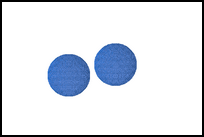
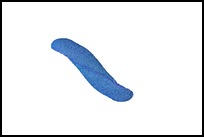
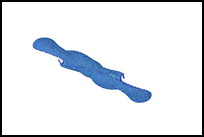
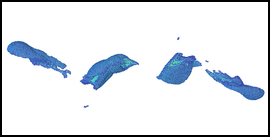
|
| Figure 4: Sequence of a collision of two dust balls (r = 1 m, 85 % porosity) at relative speed of 10 m/s with an impact parameter (offset) of 0.5 m, preliminary simulation. |
